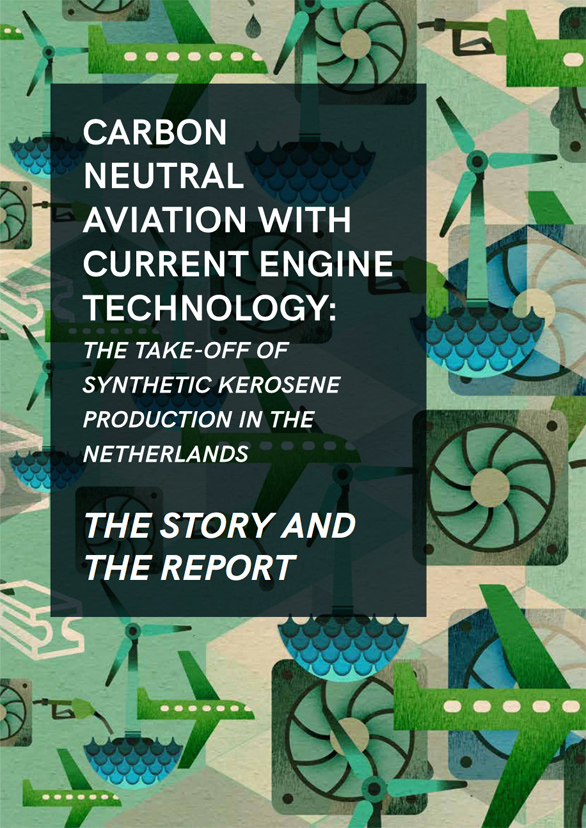This story and report analyse and discuss how and at what costs the aviation sector can become carbon-neutral in 2030, using current jet engine technology. The pathway is that of synthetic kerosene: kerosene made from a carbon source (such as CO2 from industrial flue gases from the steel industry, or the ambient air) and a hydrogen source (for instance hydrogen from water electrolysis). If hydrogen is renewable and the carbon source is a waste gas, CO2 chain emissions are reduced by 55%; if the carbon source is the ambient air, the CO2 reduction is 100%.
Specifically in the province of North Holland in the Netherlands, all ingredients are in place for synthetic kerosene production: it has CO2 from the Tata Steel steel plant, water from ’t IJ or the North Sea, electricity from offshore windfarms, kerosene storage in the terminals in the Port of Amsterdam and lastly a direct pipeline to Schiphol Airport and its consumers. With Tata Steel’s waste gases, enough kerosene can be made to fuel 50% of the airplanes that fuelled at Schiphol in 2016, saving 11 Megaton of CO2 emissions.
Lastly, techno-economic analysis also shows that synthetic kerosene costs are higher than fossil kerosene costs in 2030 in a reference scenario, but that already under very moderate assumptions price parity can be reached. This means that synthetic kerosene costs the same as fossil kerosene.
We invite you to read the story to learn more, and the detailed report if you are interested in the technicalities and calculations.
Het verhaal en rapport gaan in op hoe en tegen welke kosten de luchtvaartsector CO2 neutraal kan worden in 2030, gebruikmakend van huidige turbine technologie. Synthetische kerosine maakt dit mogelijk. Dit is kerosene geproduceerd uit een koolstofbron (bijvoorbeeld CO2 uit industriële restgassen van een staalfabriek, of de lucht) en een waterstofbron (bijvoorbeeld waterstof gemaakt door electrolyse van water). Als waterstof hernieuwbaar is en de koolstofbron een restgas is, worden CO2 emissies over de keten verminderd met 55%; als de koolstofbron de lucht is, is de CO2 emissie reductie 100%.
De provincie Noord Holland lijkt bij uitstek geschikt voor de productie van synthetische kerosine: er is CO2 van de hoogovens van Tata Steel in IJmuiden, water van ’t IJ of de Noordzee, elektriciteit van de offshore windmolens, kerosine opslag in de terminals in de haven van Amsterdam en tot slot een directe pijpleiding naar Schiphol en haar verbruikers. Met Tata Steel’s restgassen kan zoveel synthetische kerosine gemaakt worden, dat de helft van de vliegtuigen die in 2016 op Schiphol tankten daarmee voorzien kunnen worden. Dit bespaart ongeveer 11 Megaton CO2-emissies.
Tot slot laat een techno-economisch analyse zien dat synthetische kerosine in een referentie scenario duurder is dan fossiele kerosine in 2030, maar dat bij iets andere aannames prijs pariteit bereikt kan worden. Dit zou betekenen dat synthetische kerosine even duur is als fossiele kerosine.
We nodigen je uit het verhaal te lezen om meer te leren, en het gedetailleerde rapport als je ook geïnteresseerd bent in de technische details en berekeningen.
